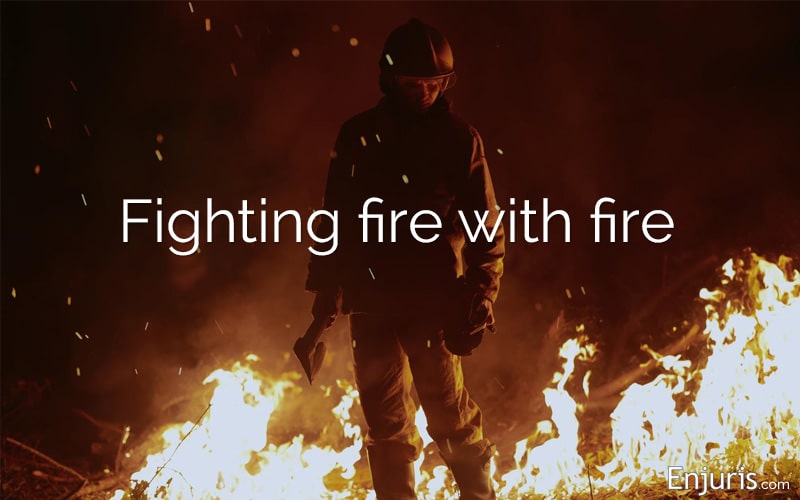[ad_1]

Jump to section
Firefighters have one of the most dangerous jobs in Montana. While many other workers are sitting at their desks in air-conditioned offices, firefighters are battling flames while the structures around them collapse.
Although firefighters may seem like superheroes, they’re not immune to common hazards. Consider the case of Sara Madsen, a 24-year-old Montana firefighter and member of the Helena Hotshot crew, who was tragically killed in a single-vehicle crash on her way home from a fire assignment on September 2, 2020.
This raises the question:
What legal options are available when a firefighter is injured or killed?
Let’s take a look.
One of the most dangerous jobs
Firefighting is one of the most dangerous jobs in America.
In addition to the obvious fire danger, firefighters put their bodies in awkward positions that often lead to back and knee injuries. What’s more, firefighters have an increased risk of cancers and musculoskeletal diseases due to exposures in their work environment.
According to the National Fire Protection Agency (NFPA), 58,250 firefighters were injured and 64 firefighters were killed in the line of duty in 2018. Additionally, 47,150 firefighters were exposed to hazardous substances, such as asbestos, radioactive materials, chemicals, and fumes.
Facing facts:In Montana, there were 9.9 firefighter injuries and 2 firefighter deaths per 1,000 fires in 2018. This was on par with the national average of 9.8 injuries and 2.5 deaths.
Legal remedies for injured firefighters in Montana
When a firefighter is injured, they may be able to receive compensation by filing a workers’ compensation claim or a third-party personal injury lawsuit depending on the circumstance.
Workers’ compensation claim
Workers’ compensation is a form of insurance that pays financial benefits to firefighters injured on the job (or to certain family members of firefighters killed on the job).
Workers’ compensation is “no-fault insurance,” which means an injured firefighter doesn’t need to prove that anyone did anything wrong to receive benefits.
Rather, all the firefighter must prove is that:
- The injury is covered by workers’ compensation insurance, and
- The injury was sustained during the “course and scope of employment.”
Most work-related injuries are covered by workers’ compensation. The focus of a workers’ compensation claim, therefore, tends to be on whether or not the injury was sustained during the course and scope of employment.
In some cases, such as when a firefighter suffers a burn injury while extinguishing a fire, it’s easy to prove that the injury was suffered during the course and scope of employment. In other cases, such as when a firefighter contracts a disease, it’s more difficult.
Enjuris tip:In 2019, Montana Governor Steve Bullock passed a law intended to make it easier for firefighters to receive workers’ compensation benefits for certain diseases. The law presumes that a firefighter’s workers’ compensation claim is valid if they are diagnosed with certain presumptive diseases, including myocardial infarction (heart attack), colorectal cancer, mesothelioma, non-Hodgkin’s lymphoma, and cancers of the esophagus, brain, lung, and breast. A firefighter must have between 4 and 15 years of service for the law to apply.
What happens if a firefighter is injured while traveling to or from work?
The general rule in Montana is that employees are not covered while going to and from work.
In 1998, the Montana Supreme Court held that a police dispatcher was not in the “course and scope of employment” when she slipped and fell on a public sidewalk on her way to work. However, the Supreme Court left open the possibility for coverage in situations in which the employer furnished the transportation, reimbursed for travel, or required specifics of travel.
As a result, it’s likely that a firefighter would be covered by workers’ compensation while traveling in a firetruck to and from a fire, but probably not when traveling in their own vehicle to and from the firehouse—as in the case of Sara Madsen.
Are volunteer firefighters covered by workers’ compensation?
In general, workers’ compensation does not cover volunteer firefighters in Montana. Fire departments can provide volunteer firefighters with workers’ compensation coverage, but they’re not required by law to do so.
Facing facts:As of 2019, roughly a quarter of the 8,000 volunteer firefighters in the state were not covered.
There has, however, been a recent movement to pass a bill requiring fire departments to provide workers’ compensation coverage to volunteer firefighters, so hopefully this changes in the coming years.
Third-party personal injury lawsuit
Workers’ compensation is an exclusive remedy. This means that most injured firefighters have to file a workers’ compensation claim instead of a personal injury lawsuit.
However, a firefighter might be able to file a third-party personal injury lawsuit in addition to a workers’ compensation claim if the injury was caused by a third party (i.e., someone other than the employer or a colleague).
Unlike with a workers’ compensation claim, firefighters will need to prove fault if they file a third-party lawsuit. In most cases, proving fault means establishing the 3 elements of negligence:
- The third-party owed the firefighter a duty of care,
- The third-party breached that duty of care, and
- The third-party’s breach was the legal cause of the firefighter’s injury.
For example, if a firefighter is hit and injured by a driver who ran a red light while on their way to put out a fire, the firefighter may be able to file a workers’ compensation claim and file a third-party lawsuit against the negligent driver.
As a firefighter, you provide an incredibly important service to Montanans. If you’re injured, the right attorney can ensure you get the benefits you deserve.
[ad_2]




